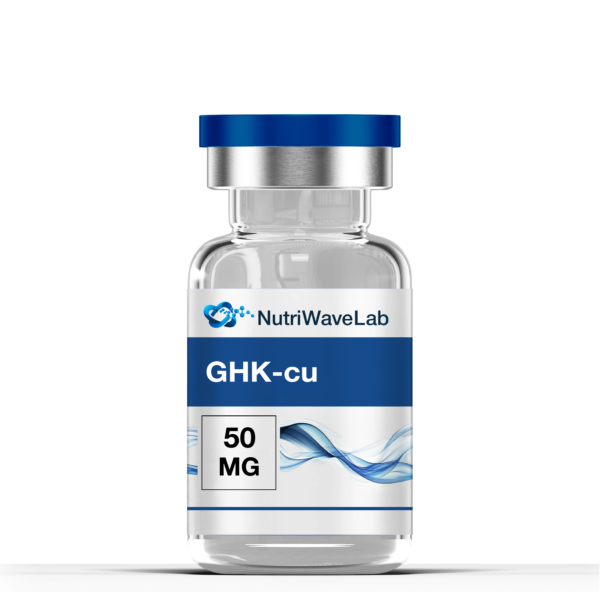GHK-cu 50mg
$0.00
- when buying 5 units of goods 5% discount
- when buying 10 units of goods 8% discount
16 in stock
GHK-Cu (Copper Tripeptide-1)
The Cellular Regeneration and Wound-Healing Peptide
Chemical Identity
-
Type: Bioactive tripeptide bound to divalent copper (Cu²⁺)
-
Amino Acid Sequence: Gly-His-Lys
-
Molecular Formula: C₁₄H₂₄N₆O₄·Cu
-
Molecular Weight: 403.86 g/mol
-
CAS Number: 49557-75-7
-
PubChem CID: 16217526
-
Synonyms: Copper Peptide, GHK-Cu Complex, Tripeptide-1 Copper, Glycyl-L-Histidyl-L-Lysine-Copper(II)
Overview
GHK-Cu is a naturally occurring copper-binding tripeptide present in human plasma, saliva, and tissues.
It was first identified in 1973 by Dr. Loren Pickart, who discovered that young individuals exhibited much higher levels of this peptide compared to older subjects.
Since then, GHK-Cu has become one of the most extensively studied molecules in regenerative and cosmetic biochemistry.
It plays a central role in tissue repair, collagen synthesis, angiogenesis, and protection against oxidative damage.
By tightly binding copper ions, it functions as a molecular transporter, delivering this essential trace element to sites of injury where repair enzymes depend on copper availability.
Mechanisms of Action
🧬 1. Collagen and Extracellular Matrix Synthesis
GHK-Cu activates fibroblasts and stimulates the synthesis of collagen types I and III, elastin, fibronectin, and glycosaminoglycans.
This leads to improved skin firmness, elasticity, and accelerated wound closure.
💎 2. Inflammation Modulation and Tissue Repair
The peptide down-regulates inflammatory cytokines (TNF-α, IL-6) while promoting anti-inflammatory signaling and epithelial regeneration.
It acts as a natural regulator of inflammation, supporting controlled tissue recovery without steroid-related side effects.
⚡ 3. Antioxidant and Mitochondrial Protection
Through its copper core, GHK-Cu enhances superoxide dismutase (SOD) activity — a major cellular antioxidant enzyme.
It reduces lipid peroxidation, stabilizes mitochondrial potential, and protects DNA from oxidative stress.
💆♀️ 4. Skin and Hair Regeneration
GHK-Cu promotes keratinocyte migration, activates skin stem cells, and enhances dermal microcirculation.
Research shows increased hair follicle activity, thicker shafts, and extended anagen (growth) phase during topical or local application.
🧠 5. Neuroprotective and Systemic Regeneration
In in vitro studies, GHK-Cu demonstrated neuroprotective and anti-apoptotic activity, reducing glial inflammation and improving microvascular health.
It supports recovery of tissues under ischemic and hypoxic conditions.
Research Background
🧪 In Vitro Studies
-
Models: Keratinocytes, fibroblasts, endothelial cells
-
Methods: Gene-expression profiling, microscopy, collagen quantification
Findings: -
Up-regulation of more than 400 genes related to wound healing and tissue remodeling
-
Enhanced collagen and growth-factor synthesis
-
Accelerated closure of cellular wounds under stress conditions
🧍♂️ In Vivo Animal Research
-
Models: Burns, skin wounds, alopecia, and age-related tissue decline
Results: -
Wound healing accelerated by 30–50 % compared to control
-
Restoration of collagen fiber networks and capillary density
-
Noticeable dermal thickening and improved hair density
-
Enhanced elasticity and reduced wrinkle depth in topical models
👩⚕️ Human Clinical Observations
Volunteer studies show GHK-Cu is safe, non-irritating, and effective in improving skin texture and tone.
It is widely used in cosmetic dermatology and regenerative protocols — including serums, mesotherapy formulations, microneedling cocktails, and cell-rejuvenation blends.
Primary Research Directions
| Field of Study | Reported / Investigated Effects |
|---|---|
| Dermal & Connective Tissue Repair | Increases collagen, elastin, and matrix proteins |
| Antioxidant Defense | Activates SOD, protects mitochondrial membranes |
| Wound Healing | Accelerates epithelial regeneration, modulates inflammation |
| Hair Growth | Stimulates follicular stem cells and angiogenesis |
| Neuroprotection | Reduces oxidative and inflammatory neuronal stress |
Biological Significance
GHK-Cu functions as an endogenous signal peptide essential for tissue remodeling and homeostasis.
Its levels naturally decline with age, correlating with slower wound healing and loss of skin elasticity.
By restoring copper bioavailability and activating regenerative gene networks, GHK-Cu acts as a cellular trigger for repair and renewal.
Scientific Outlook
Current research explores the broader roles of GHK-Cu in:
-
Epigenetic and anti-aging pathways
-
Diabetic wound and vascular repair
-
Neuroprotection in ischemia and neurodegeneration
-
Synergistic mitochondrial protocols alongside MOTS-C, SS-31, and Thymosin-α1
GHK-Cu is increasingly recognized as a “molecular signal switch” capable of shifting cells from a damaged to a regenerative state — bridging cosmetic science and regenerative medicine.
⚠️ Disclaimer
GHK-Cu (Copper Tripeptide-1) is supplied for research and educational purposes only.
It is not approved for human or veterinary use, and not intended to diagnose, treat, or prevent any disease.
Product Use: THIS PRODUCT IS STRICTLY FOR
SCIENTIFIC RESEARCH PURPOSES ONLY. It should only be used in laboratory
settings. All product information on this website is provided solely for
educational purposes. The law strictly prohibits introducing this product into
the body of humans or animals. Only licensed professionals should handle this
product. This product is not a drug, food, or cosmetic and should not be
improperly classified or used as such.



Reviews
Clear filtersThere are no reviews yet.